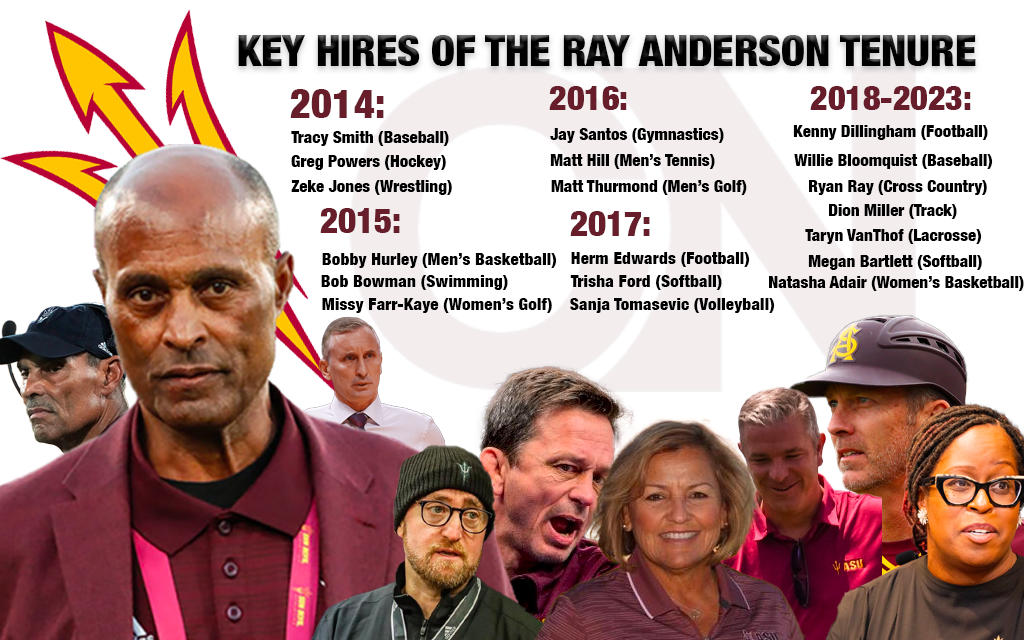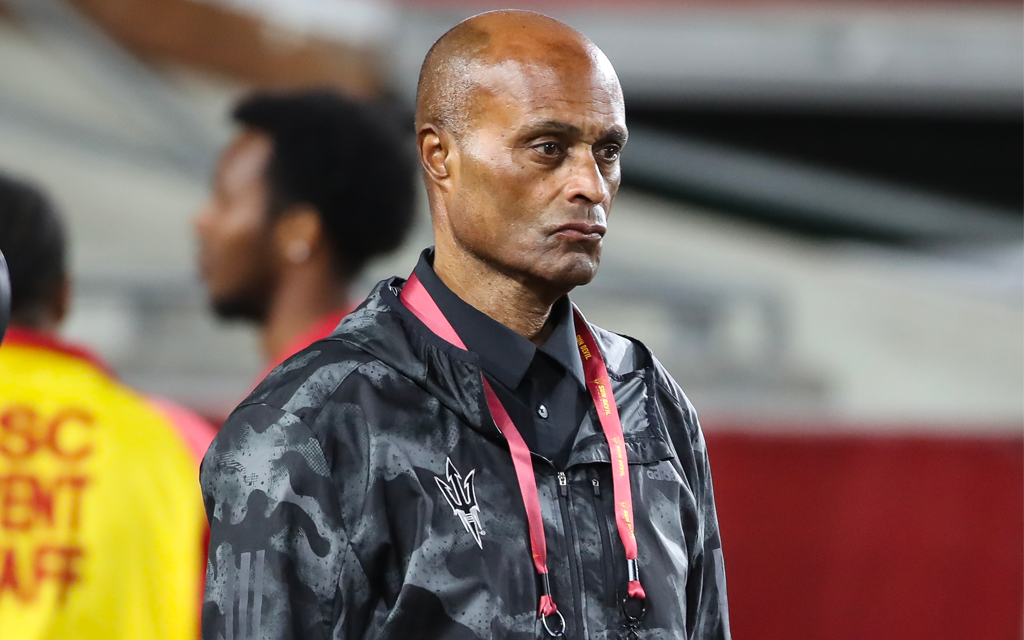TEMPE – Just two days ago, Ray Anderson stood on the sidelines of the Rose Bowl as Arizona State football players celebrated an upset of UCLA. The chants from visiting ASU fans, however, had nothing to do with the victory.
“Ray, you suck! Ray, you suck!”
The words were apparently a harbinger. On Monday, Anderson announced his resignation as vice president of university athletics, effective immediately.
He will remain a professor of practice at ASU and a senior advisor to help expand the sports law and business program at the Sandra Day O’Connor College of Law, according to a release from the university.
“It has been a privilege to serve as ASU’s athletic director for nearly a decade,” Anderson, 69, said in a written statement. “We have entered an unprecedented era where the number and magnitude of changes in the college sports landscape are astounding. As I approach my (70th birthday), these are not matters that my leadership would be able to corral during my tenure. Continuity of leadership will be needed, and I am choosing to step aside to let the university find that leader.”
Jim Rund, ASU’s senior vice president for educational outreach and student services, will serve as interim athletic director. Rund was interim athletic director in 2013 following the departure of Steve Patterson to the University of Texas.
The news follows ASU’s 17-7 victory over UCLA Saturday at the Rose Bowl, where first-year coach Kenny Dillingham secured his second conference win. Dillingham said he found out in Monday’s morning meetings, just before the news was announced.
“I’m thankful for him giving me the opportunity to be the head coach at my alma mater, my dream job,” Dillingham said. “We’ll look forward to what the future holds here, but best of luck to him in the future.”
Anderson’s departure follows a tumultuous period for ASU athletics, highlighted by an ongoing NCAA investigation into the football program for recruiting violations committed by former assistant coaches during the COVID-19 dead period. After that, ASU parted ways with former coach Herm Edwards and self-imposed a postseason ban on the football team for this season.
The investigation’s aftermath led to the current dark period of ASU football, which is 6-16 over the past two seasons.

ASU offensive lineman Juan Roque, who was a starter on the Sun Devils’ 1996 Rose Bowl team, saw the writing on the wall once the recruiting scandal became public.
“The fact we’re being investigated was a low light,” Roque said. “We had all these accusations of breaking rules. While I have no doubt that other schools were doing it, the fact is we got caught and you can’t be doing that stuff. That put the school in a really bad place. We lost recruits, we lost players. So in the end, I think that the way it ended was just horribly perforate, but also horribly for our program.”
Many fans have been calling for Anderson’s firing since the bowl ban was announced, booing him during game appearances and funding a “#FireRayAnderson” mobile billboard that has been seen making the rounds near the Tempe campus.
Anderson has also been criticized for ASU’s slow commitment to NIL support, which Dillingham has been outspoken about in the past. He was again Monday.
“Any time there’s change, it rattles enough cages to get some people involved and understand that there’s a direction we’re heading,” Dillingham said. “With NIL, we’ve got about a month (until the offseason starts), but we got to step it up. We got to get rolling at a rapid, rapid, rapid, rapid rate in these next three weeks to one month.”
Shortly after the announcement, the Sun Angel Collective was already asking ASU fans and boosters to donate. Donations already were flowing in, including from former ASU lineman Corey Stephens, who posted on social media that he had contributed.
Can we rally together and bring in 500 new members today? Spread the word, tag your friends, and let's make this happen!https://t.co/Ekh9pvOkG7
— Sun Angel Collective (@SunAngelNIL) November 13, 2023
“If we are going to be successful in today’s landscape of college sports, we are going to need help, and that’s for every sport,” said ASU baseball coach Willie Bloomquist, echoing Dillingham’s urgency. “That’s not a threat. That’s not a cry. That’s just the honest truth. We’re going to fall further behind if we don’t start getting some help from people.”
Anderson was named athletic director in 2014. At ASU, he added new programs including the school’s fast-improving men’s ice hockey team, highly successful women’s triathlon team and women’s lacrosse program. He reinstated a men’s tennis program that disbanded in 2008, donating $1 million of his own money to the cause. He also hired two national coaches of the year and six Pac-12 coaches of the year.
Other notable Anderson hires include Dillingham, Edwards, Bloomquist, and men’s basketball coach Bobby Hurley.
“He gave me the opportunity to come back to this place, which I love,” Bloomquist said. “You never like seeing a guy get fired, just because a man’s a human being and he’s a good human. But on the same token, we’ve been taught to think onward to the next thing, and we understand that this is a business and things happen.”
Anderson’s contract, which Cronkite News obtained, reveals that compensation will hinge on the definition of his termination.
In the event Anderson terminated his contract “with good reason,” the university is obligated to pay Anderson his salary and performance bonuses earned through the termination date as well as potential liquidated damages, which amount to two times his current salary (at least $950,000). If Anderson resigns without “good reason,” the University will owe Anderson the salary and bonuses earned through the termination date, as well as “any benefit continuation rights as required by law.”
If Anderson had been fired with cause, the university would have owed Anderson the salary and bonuses earned through the termination date, as well as “any benefit continuation rights as required by law,” unless there were NCAA violations, in which case Anderson would owe any “special compensation or performance bonus” paid after the infractions back to ASU.
However, because Anderson will still remain employed by the university, the amount he will receive through the end of his contract remains uncertain.
Anderson also oversaw the construction of ASU athletic complexes, including the $134 million multi-purpose Mullett Arena and the beach volleyball facility, and led the $307 million renovation of Mountain America Stadium. He also was behind ASU baseball’s move to Phoenix Municipal Stadium and the men’s and women’s golf teams move to The Thunderbird at Papago Golf Course.
The next athletic director will be tasked with leading ASU in its transition to the Big 12 and navigating the ever-changing landscape of NIL.
“I personally like Ray, as a person, I think that he’s a great guy,” Roque said. “He’s done his best, given all the circumstances and whatnot. But sadly, the state of the program is just we’re just not in a good place. Sometimes that requires not only a coaching change but also a change in the direction of the whole, athletic department.”
The athletic department’s top donors had similar viewpoints. Eddie Sandidge appreciated Anderson’s love for all ASU sporting events.
“When I met him for the very first time, he was at a girl’s basketball game, and he was down there cheering for our girl’s basketball team,” Sandidge said. “I introduced myself and we became friends. He went to all the games and donated a million dollars to our athletic program out of his own personal wealth. He’s a good person.”
Both Sandidge and his close friend and fellow donor Charles “Nap” Lawrence graduated from ASU and are among the top contributors to the program. They still attend ASU games and acknowledged what Anderson has accomplished for the school.
“I’m pretty close to the program,” Lawrence said. “Ray had done a lot of good things for Arizona State and a lot of people will forget that. … I think he’ll be happier now. I hope he is because he’s been a dear friend and his wife has also been wonderful.”
Lawrence recently donated a million dollars to ASU after Anderson hired Kenny Dillingham to be the next football coach. He’s a big fan of the coach and predicts he will eventually be known as one of the school’s best
Now, they’ll help in the search for the new athletic director. Lawrence wants someone who has the ability to communicate with all kinds of people. Sandidge’s wish is simple.
“I want a winner of course,” Sandidge said. “Winning’s everything. It’s not a lot of fun going out and seeing your team get killed. I mean, one of the most fun days of my life was when we won the Rose Bowl. I was asked what was the best day of my life. Well, the year we beat Jim Harbaugh and Michigan in the Rose Bowl. My wife said what about our wedding? What about the birth of our child? Well, those were exciting days, but the Rose Bowl win is right up there with them.”
Both boosters praised Anderson, as did Roque.
“I think this is just the outcome that I think we all anticipated when Herm (Edwards) was let go,” he said.
“We kind of knew that he was going to be the next domino to fall.”
And that’s exactly what happened Monday.


